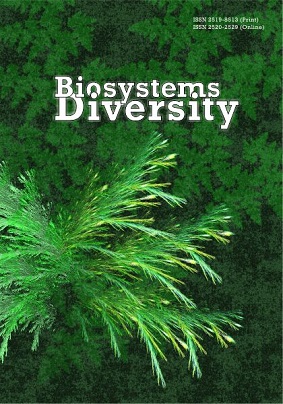Вплив активних форм кремнію на біомасу сільськогосподарських культур під час їх вирощування на техногенно порушених ґрунтах Нікопольського марганцеворудного басейну
The effect of active forms of silicon on the biomass of agricultural crops during their growth period on technogenically altered soils of the Nikopol Manganese Ore Basin
Author(s): V. I. Chorna, I. V. WagnerSubject(s): Agriculture, Sociobiology, Environmental interactions
Published by: Дніпропетровський національний університет імені Олеся Гончара
Keywords: silicon compounds; sunflower; buckwheat; vetch; pedosoil; sod-lithogenic soils; gray-green clays;
Summary/Abstract: The problem of recovery of technogenically affected soils remains unsolved. Silicon which moves in the “soil – plant” system has been insufficiently studied, though this element takes part in many processes. For assessing the role of silicon compounds, we selected samples of technogenically affected soils of different types in the territory of the research station for land reclamation of Dnіpro State Agrarian-Economic University in the Nikopol Manganese Ore Basin. We conducted a vegetative experiment and a series of laboratory tests with adding SiO2. We chose the following crops: buckwheat (Fagopyrum esculentum Moench, 1794), vetch (Vicia sativa Linnaeus, 1753) and sunflower (Helianthus annuus Linnaeus, 1753). The рН of the studied soils fluctuated between 7.1 to 7.8. The content of available nitrogen and phosphorus in the soils was low, except the content of phosphorus in pedozems. We analyzed 240 samples of plants and measured their biomass. Vetch grew best on sod-lithogenous soils on forest-like lomy soils, buckwheat and sunflower – on sod-lithogenous soils on grey-green clays. The variant of experiment with 0.2% solution of SiO2 was most the efficient during growing all chosen crops on all types of studied soils. After adding amphoteric silicon, the best biomass indicators of vetch and buckwheat were observed on sod-lithogenous soils on forest-like loam, and indicators for sunflower – on sod-lithogenous soils on grey-green clays. After using 0.3% and 0.4% solution of SiO2, a gel film forms, which the seeds have no energy to penetrate and run out. Thus it slows the plant’s growth. An exception was an experiment with pedozems with adding 0.4% solution of SiO2, when the biomass of vetch was 1.5 times greater than in the experiment with 0.2% solution. We observed no similar positive effect in other variants of the experiment. All chosen crops on technogenically affected soils reacted to addition of silicon compounds by increasing biomass under the influence of SiO2 solutions with concentration higher than 0.2%. Possibly, the increase in biomass during the first 14 days is connected with adsorbing activity of silicon, which retains water and accelerates the development of plants. Even with low content of available nitrogen and phosphorum, addition of silicon compounds increased the biomass of plants by two-four times, therefore silicon in this case is a limiting factor.
Journal: Biosystems Diversity
- Issue Year: 25/2017
- Issue No: 2
- Page Range: 74-81
- Page Count: 8
- Language: Ukrainian

